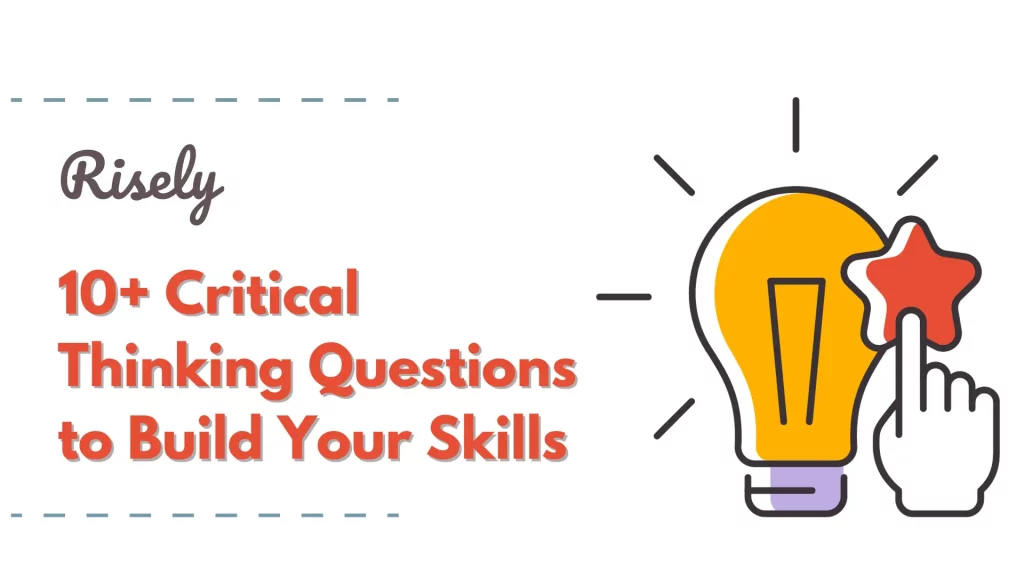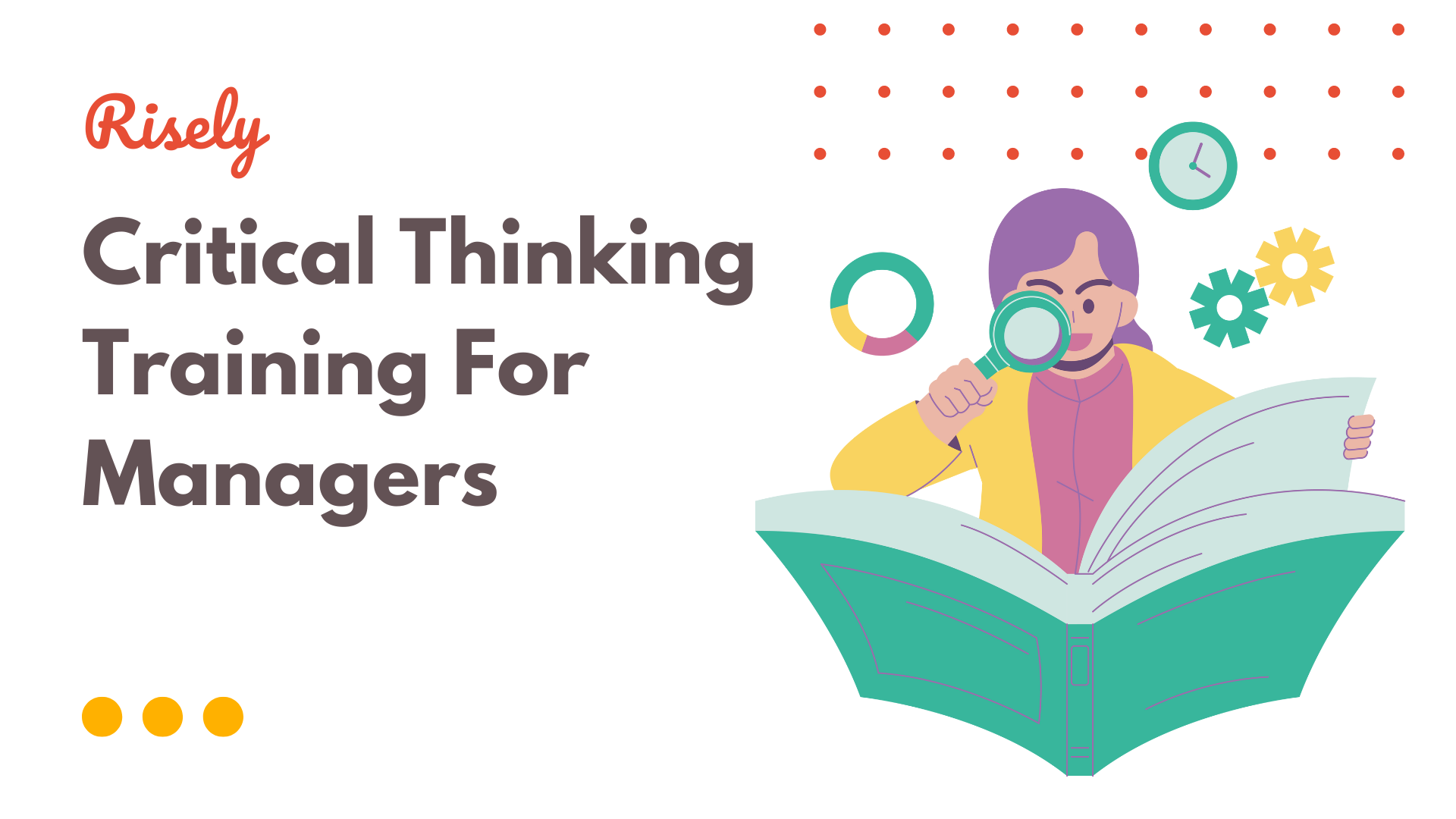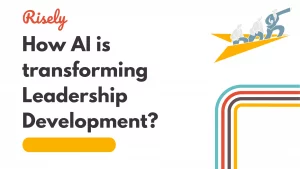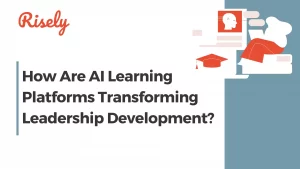10+ Critical Thinking Questions to Build Your Skills
Critical thinking has become crucial for success in any field in today’s fast-paced and information-rich world. And the arena of management is definitely one of those. Critical thinking involves analyzing information, evaluating arguments, and making informed decisions based on evidence and reasoning. One of the most effective ways to develop your critical thinking skills is by asking the right questions. In this blog, we’ll explore some of the most important critical thinking questions that managers and leaders can use to enhance their abilities and improve their overall performance, whether at work or in their personal lives. So, let’s hop on!What is Critical Thinking for Leaders?
Critical thinking objectively analyzes, evaluates, and synthesizes information to form a judgment or decision. It involves examining information from multiple perspectives, questioning assumptions, identifying biases, and weighing evidence to reach logical conclusions. Critical thinking is essential because it allows you to assess information and arguments critically instead of unquestioningly accepting them as genuine. It enables you to identify faulty reasoning, inconsistencies, and gaps in arguments, which helps you make informed decisions and take responsible actions. In addition, critical thinking allows leaders to develop better communication skills, as they can articulate their ideas and opinions more effectively. As the world increasingly moves toward a technologically advanced way of working, critical thinking is one of the key factors in ensuring professional success as a manager in the era of AI and management working together. Hence, building your critical thinking skills is the need of the hour!Why Do You Need Critical Thinking Skills at Work?
Critical thinking is essential in the workplace for several reasons:- Problem-solving: In any workplace, there are bound to be problems that arise. Critical thinking enables employees to analyze the problem from different angles, identify the root cause, and develop effective solutions.
- Decision-making: Critical thinking is crucial when making important decisions. Employees with strong critical thinking skills can better weigh the pros and cons of various options, anticipate potential outcomes, and make informed decisions.
- Innovation: Critical thinking enables employees to think outside the box and develop innovative solutions to problems. Employees can identify new and creative ways to approach problems by examining the situation from different perspectives.
- Communication: Effective communication is essential in any workplace. Critical thinking helps employees to communicate their ideas clearly and persuasively. It also enables employees to listen actively, ask insightful questions, and respond thoughtfully.
- Time management: In fast-paced work environments, employees must make decisions quickly. Critical thinking lets employees quickly analyze information and make informed decisions without sacrificing quality.
Critical Thinking Questions for Managers and Teams
When we think of great managers, we often go to people who have solved challenges smartly and beaten down out-of-the-box challenges with even more innovative solutions. We can conclude one thing by looking at some examples of critical thinkers below.

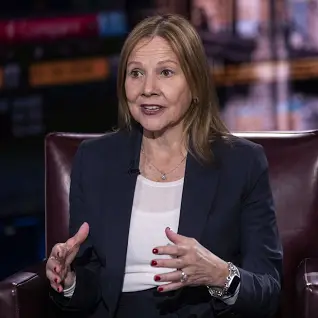

Critical Thinking Questions for Decision-Making and Planning
What problem or issue are we trying to solve, and what are the underlying causes?
This first critical thinking question encourages managers to clarify the nature of the problem or challenge and understand its root causes. It is a crucial first step in any problem-solving process, enabling you to develop targeted solutions that address the underlying issues rather than just the symptoms. To answer this question, you should first define the problem or issue they are trying to solve in clear and specific terms. Once they clearly understand the problem and its root causes, they can develop and implement targeted solutions that address the underlying issues. Let’s see this situation with an example –A manager leads a team that needs help meeting its sales targets. Rather than simply increasing sales numbers, the manager first tries to understand the issue’s root causes. After conducting research and analysis, the manager identifies that the team needs more sales training and skills to engage with potential customers effectively. With this understanding, the manager can develop targeted training and coaching programs to improve the team’s sales skills, ultimately leading to better sales performance.
What are the potential consequences of different courses of action, and how can I mitigate risks?
This critical thinking question encourages leaders to consider the potential outcomes of different options and assess the associated risks. It enables you to make informed choices that consider both their actions’ short-term and long-term consequences during the decision-making process. You should identify their options and evaluate their potential outcomes to answer this question. Next, you should consider costs, benefits, and potential risks and weigh the pros and cons of each option. Once you have a clear understanding of the possible consequences of each option, you can then develop strategies to mitigate risks and maximize benefits. Here’s an example to illustrate this better –A manager is considering launching a new product line. Before making a decision, the manager should evaluates the consequences of different courses of action. They consider factors such as market demand, production costs, and potential profitability, as well as potential risks such as supply chain disruptions or low sales volume. With this understanding, the manager then develops strategies to mitigate risks and maximize the chances of success. By taking a thoughtful and strategic approach to decision-making, the manager can increase the chances of success and minimize potential negative consequences.
What data do I need to make an informed decision, and how can I ensure its accuracy and reliability?
This critical thinking question encourages managers to take a data-driven approach to decision-making, ensuring that decisions are informed by accurate and reliable information. This is important because decisions based on complete or accurate information can be costly and damaging to organizations. Here’s how this situation can look like for a marketing manager –A manager is considering expanding into a new market. To make an informed decision, the manager needs data on market size, consumer demographics, competitor analysis, and potential regulatory barriers. The manager then works to ensure the accuracy and reliability of this data, which involves validating sources, cross-checking data against multiple sources, and engaging experts in the field to provide additional insights.
What are the potential unintended consequences of the actions, and how can I minimize them?
This critical thinking question encourages managers to think critically about the potential unintended consequences of their decisions and actions. It is important because unintended consequences can significantly impact a team. Hence, when thinking along these lines, go beyond the first level. Imagine all the possibilities and the second and third-order impacts it can bring. Now, this sounds like a challenging prospect, but here’s an example to help you visualize how it works.A manager is considering implementing a new cost-cutting measure, such as reducing employee benefits. While this may help the organization save money in the short term, it could also have unintended consequences, such as reduced employee morale and increased turnover. To minimize these unintended consequences, the manager could consider alternative cost-cutting measures or work to mitigate the impact on employees by providing additional support or incentives.
Read more: Managers can make or break company growthHow can I test the assumptions and hypotheses, and what metrics can I measure success?
This critical thinking question encourages managers to think critically about their assumptions and test them rigorously to ensure they make informed decisions based on reliable data. It is essential because assumptions that must be tested can lead to flawed decision-making and ultimately harm the organization. To answer this question, you should identify the assumptions and hypotheses underlying their decisions or strategies. It may involve working with your team to brainstorm potential assumptions or hypotheses and then prioritizing them based on their importance to the decision. Once these assumptions have been identified, managers should work to test them rigorously, using reliable data and metrics to measure success. Here’s how this process looks in action –A manager is considering launching a new product. The manager has assumptions about the market demand for the product, customer preferences, and production costs. To test these assumptions, the manager conducts market research, analyzes customer feedback, and conducts cost-benefit analyses to determine the product’s viability. The manager then sets metrics for success, such as sales targets or customer satisfaction ratings, and tracks these metrics over time to determine if the product is meeting expectations.
How can I anticipate and prepare for potential roadblocks or obstacles and develop contingency plans?
The critical thinking question encourages managers to think critically about potential challenges and develop strategies to overcome them. It is essential because unexpected roadblocks can disrupt progress and lead to missed opportunities, while preparedness can ensure that the organization can pivot quickly and efficiently.A manager oversees the development of a new product dependent on a key supplier for a critical component. The manager anticipates potential roadblocks, such as delays or quality issues with the supplier, and develops contingency plans to identify alternate suppliers or develop in-house capabilities for the component. In addition to developing contingency plans, the manager also communicates and aligns these plans with relevant stakeholders, including team members and leadership. It helps ensure everyone is on the same page and prepared to pivot if necessary.
How can I learn from past experiences and mistakes and apply those lessons to the current situation?
This critical thinking question encourages managers to think critically about past experiences and use those lessons to inform current decision-making. This is important because past experiences can provide valuable insights and help to avoid repeating mistakes or missed opportunities.A manager oversaw a marketing campaign that failed to generate the desired results. After analyzing the campaign, the manager identified that the messaging was unclear and did not effectively communicate the product’s value proposition. When planning a new campaign for a similar product, the manager could apply the lessons learned by ensuring the messaging is clear and effectively communicates the value proposition.
Critical Thinking Questions for Team Building
How can I leverage our team’s diverse perspectives and expertise to generate creative solutions?
This critical thinking question encourages managers to tap into their team’s collective knowledge and experience to generate innovative and practical solutions to problems. This is important because diverse perspectives can bring new insights, ideas, and approaches to problem-solving, leading to better outcomes and increased team engagement and satisfaction. To answer this question, managers should first identify the problem or challenge and then work to engage their team in the solution process. This may involve brainstorming sessions, cross-functional collaboration, or team-building activities encouraging open communication and idea-sharing.A manager is tasked with improving customer satisfaction ratings. The manager could convene a cross-functional team, including representatives from sales, customer service, marketing, and product development. The team could then use brainstorming sessions or design thinking techniques to generate creative solutions, drawing on their diverse perspectives and expertise to create innovative ideas. By involving the team in the solution process, the manager not only taps into the collective knowledge and experience of the team but also increases buy-in and engagement around the solution.
What is the long-term impact of my decisions, and how can I ensure they align with our organization’s mission and values?
This critical thinking question encourages managers to think beyond short-term gains and consider the broader impact of their decisions on the organization’s stakeholders. This is important because decisions prioritizing short-term gains over long-term sustainability can damage the organization’s reputation, create financial and legal risks, and harm the broader community.A manager overseeing a manufacturing operation may need to make decisions about sourcing raw materials or disposing of waste products. By considering the long-term impact of these decisions, the manager could work to identify suppliers who prioritize sustainability and implement practices that reduce waste and minimize environmental harm.
How can we effectively communicate our decisions to the team to gain buy-in and support?
Effective communication is crucial for gaining the team’s trust, commitment, and support for decisions made by the manager. Transparent communication can address any concerns or uncertainties, reducing resistance to change and building a more positive work environment. When team members feel heard and involved in the decision-making process, they are more likely to be invested in the team’s goals and demonstrate greater dedication to achieving them.A manager observes that their team feels disconnected from the work being done daily. Upon thinking, the manager understands that the team needs to be made aware of the rationale behind decisions made by the management. They can explore various communication strategies and channels to ensure team members understand the rationale behind decisions.
What feedback mechanisms can we implement to regularly assess and enhance our processes?
Regularly seeking feedback and implementing feedback mechanisms is essential for continuous improvement. Managers demonstrate their commitment to learning and growing as a team by asking this question. Feedback allows the team to identify areas of strength and areas for improvement in their processes and performance. It helps recognize best practices, address bottlenecks, and adapt to changing circumstances or market demands.A manager observes little performance improvement even after reviews and appraisals are over. They conclude that the feedback mechanisms are insufficient as they work infrequently and without coordination for follow-ups. It helps them search for better processes to implement with their team.
Thinking, Critically
In conclusion, critical thinking questions are powerful tools to help you make better decisions, solve complex problems, and achieve your goals. By asking the right questions, you can gain a deeper understanding of the issues at hand, challenge assumptions, and identify new opportunities for growth and improvement. Remember that critical thinking is not a one-time event but a lifelong practice requiring dedication, effort, and continuous learning. So, commit to developing your critical thinking skills by regularly asking yourself and others thought-provoking questions. By doing so, you’ll not only enhance your performance but also inspire others to think more critically and creatively. And together, we can build a better future by embracing the power of critical thinking. Critical thinking skills are one of the essential areas to succeed in a leader’s role. If you ever wonder how things are going, fret not! Grab Risely’s free critical thinking self-assessment and get in-depth insights and suggestions to become the leading manager you have always wanted to be.Suprabha, a versatile professional who blends expertise in human resources and psychology, bridges the divide between people management and personal growth with her novel perspectives at Risely. Her experience as a human resource professional has empowered her to visualize practical solutions for frequent managerial challenges that form the pivot of her writings.
Test your critical thinking skills for free to start growing.
The free critical thinking assessment helps managers discover the hurdles to their growth.
Critical Thinking Questions FAQs
How do you encourage critical thinking in employees?
How can teams improve critical thinking skills?
What are critical thinking questions?
What are 3 important things to consider in critical thinking?
Other Related Blogs

